Class 9 Science Chapter 5 Question Answers - The Fundamental Unit of Life
Q1: Who discovered cells, and how?
Ans: Robert Hooke, an English scientist, discovered cells in 1665. While examining a tiny slice of cork under his self-designed microscope, he saw a honeycomb-like structure.
Q2: Why is the cell called the structural and functional unit of life?
Ans: Because all living organisms are made up of cells, the cell is the basic construction unit of a living organism, and all of a living organism's activities are the sum of activities conducted by its cells, the cell is referred to as the structural and functional unit of life.
Q3: Why is the plasma membrane called a selectively permeable membrane?
Ans: The plasma membrane is a very distinct structure. It is made up of lipids and proteins that selectively allow the entry of some molecules into the cell while preventing the exit of others, making it selectively permeable.
Q4: If the organisation of a cell is destroyed due to some physical or chemical influence, what will happen?
Ans: Because all of a cell's components are digested by its lysosomes, if the cell's organisation is damaged by some physical or chemical action, the cell will not survive.
Q5: Why are lysosomes known as suicide bags?
Ans: Lysosomes are organelles inside cells that contain hydrolytic (digestive) enzymes. When a cell is injured, its lysosomes may burst, allowing enzymes to digest the cell itself. As a result, we can call lysosomes "suicide bags."
Q6: What would happen if the plasma membrane ruptures or breaks down?
Ans: The rupture or breakdown of a cell's plasma membrane signals that the cell has been injured, and in this case, the damaged cell's lysosomes may burst, causing the digestive enzymes inside those lysosomes to eat their own cell. The cell will die as a result of this.
Q7: What would happen to the life of a cell if there was no Golgi apparatus?
Ans: The preservation, modification, and packaging of products in particles are all tasks of the Golgi apparatus. All types of storage, modification, packaging and dispatch of materials within and beyond the cell would be impossible if there was no Golgi apparatus for the cell.
Q8: Which organelle is known as the powerhouse of the cell? Why?
Ans: The cell's Mitochondria, also known as the cell's powerhouse, synthesises energy in the form of ATP during respiration, which is essential for many living processes.
Q9: Where do the lipids and proteins constituting the cell membrane get synthesised?
Ans: There are two types of endoplasmic reticulum:
(i) The smooth endoplasmic reticulum (SER) is in charge of producing the lipids that make up the cell membrane.
(ii) The ribosomes are housed in the rough endoplasmic reticulum (RER), which is responsible for the production of proteins that make up the cell membrane.
Q10: How do substances like CO2 and water move in and out of the cell? Discuss.
Ans: The exchange of gases CO2 and O2 between cells takes place by a diffusion process.
Diffusion is the migration of a chemical from a high-concentration region to a low-concentration zone. CO2 is produced inside the cell as a result of respiration and accumulates in the cell, resulting in a high concentration of CO2 in the cell compared to the outside environment. However, because O2 is used inside the cell during respiration, its concentration declines inside the cell while remaining relatively high in the environment. As a result, CO2 diffuses out of the cell and O2 diffuses in.
Q11: Fill in the gaps in the following table illustrating the differences between prokaryotic and eukaryotic cells.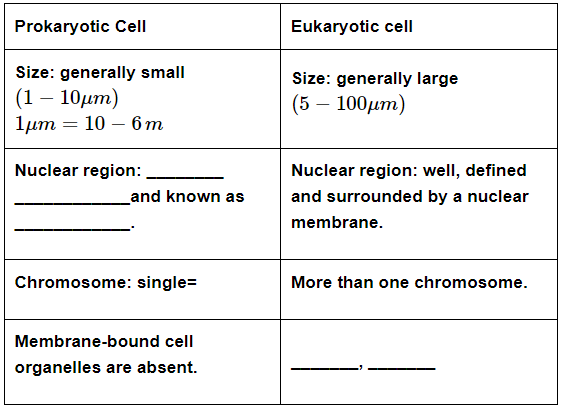 Ans: The difference between prokaryotic cell and eukaryotic cell as follows:
Ans: The difference between prokaryotic cell and eukaryotic cell as follows: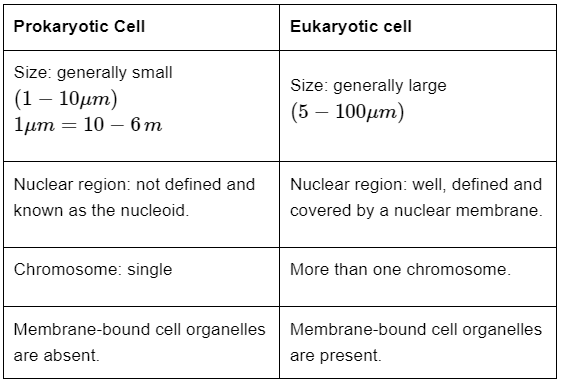
Q12: Make a comparison and write down ways in which plant cells are different from animal cells.
Ans: The difference between plant cells and animal cells is as follows: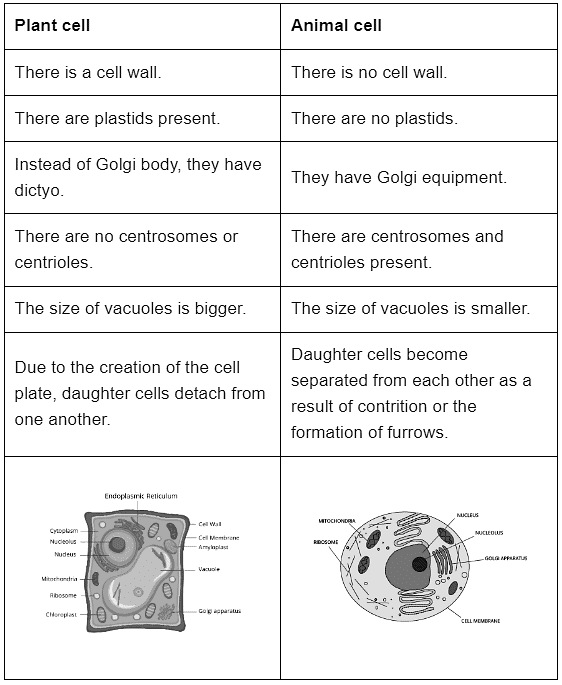
Q13: How is a prokaryotic cell different from a eukaryotic cell?
Ans: The difference between prokaryotic cell and eukaryotic cell as follows: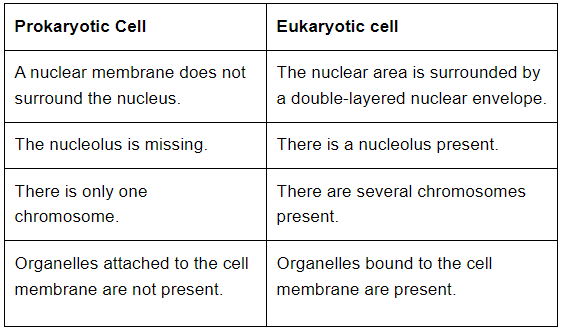
Q14: How does an Amoeba obtain its food?
Ans: Amoeba feeds on planktonic bacteria that float in water. It grows artificial feet, or pseudopodia, to encircle the meal and then catches it in a sac-like structure called the food vacuole, within which food digestion occurs.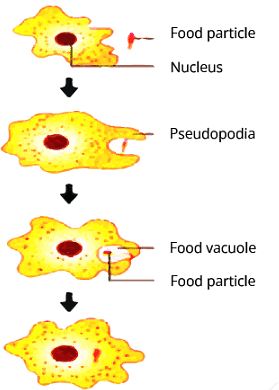 Process showing Amoeba obtaining its food
Process showing Amoeba obtaining its food
Q15: What is osmosis?
Ans: The passage of water (solvent) through a semipermeable membrane from a location of high-water concentration to a region of low water concentration is known as osmosis. It can only happen in a liquid medium; it cannot happen in solids or gases. Plant roots, for example, absorb water from the earth.
Q16: Carry out the following osmosis experiment:
Take four peeled potato halves and scoops each one out to make potato cups. One of these potato cups should be made from a boiled potato. Put each potato cup in a trough containing water. Now,
(a) Keep cup A empty
(b) Put one teaspoon sugar in cup B
(c) Put one teaspoon salt in cup C
(d) Put one teaspoon of sugar in the boiled potato cup D.
Keep these for two hours. Then observe the four potato cups and answer the following:
(i) Explain why water gathers in the hollowed portion of B and C.
Ans: When we add one teaspoon of sugar in cup B and one teaspoon salt in cup C, we create a hypertonic solution within, which allows water from outside to enter through osmosis and accumulate in the hollowed area of cups B and C.
(ii) Why is potato A necessary for this experiment?
Ans: To observe osmosis, you'll need Potato A.
(iii) Explain why water does not gather in the hollowed-out portions of A and D.
Ans: Because there is no solution (liquid medium) in the hollowed-out portions of A and D, osmosis cannot occur, and water does not collect.
|
84 videos|541 docs|60 tests
|

















